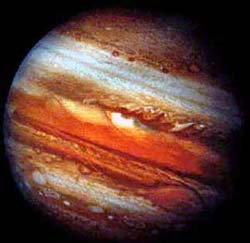Space scientist proposes new model for Jupiter’s core

The planet Jupiter may have a core of tar, according to new reasearch from WUSTL.
After eleven months of politics, now it’s time for some real “core values” – not those of the candidates but those of the great gas giant planet, Jupiter.
The planet Jupiter may have a core of tar, according to new reasearch from WUSTL.
Katharina Lodders, Ph.D., Washington University in St. Louis research associate professor in Earth and Planetary Sciences in Arts & Sciences, studying data from the Galileo probe of Jupiter, proposes a new mechanism by which the planet formed 4.5 billion years ago.
The widely accepted model for Jupiter’s formation assumes that its overall composition is similar to that of the Sun, with enrichments of oxygen and other elements heavier than helium. Jupiter’s core was believed to be a massive snowball that formed in the cold reaches of the outer solar nebula, the gas and dust cloud from which the solar system formed. However, the Galileo probe mass spectrometer found much less water than expected in Jupiter’s atmosphere.
Taking the mass spectrometer data and earlier Earth-based infrared spectroscopic measurements at face value, Lodders calculated that Jupiter is depleted in water and thus in oxygen. The Jovian oxygen inventory is only about half of the oxygen elemental abundance in the Sun. On the other hand, the Galileo probe mass spectrometer data show that Jupiter’s carbon inventory is about 1.7 times larger than that in the Sun. Based on these data, Lodders argues that Jupiter’s core was mainly tar instead of ice.
Snow line yields to tar line
Lodders’ theoretical model assumes an outer solar system warmer than previously thought. Her theory replaces what astronomers call the “snow line,” the point in the solar nebula where water ice condenses, with the new “tar line,” the point where asphalt or tar-like material formed, pushing the snow line farther out in the solar nebula.
Picture a snowy street in winter and a fresh layer of tar on part of that street.
“Snow will evaporate with warmer temperatures but the tar will stay” said Lodders. “Also consider the fact that organics make a kind of sticky goo, which is good for gathering rocks and building the core. Imagine an ice cube and sticking bits of rock to it, then think of maple syrup. What’s going to have better sticking properties?”
Jupiter’s core formed rapidly relative to the rate at which gas was lost from the solar nebula. Once its core reached about 10 Earth masses, gravitational attraction captured the surrounding nebular gas and built up the gas giant planet we observe today. The core question, if you will, is: If there was a lot of water ice that helped to built the Jovian core, where is the water now?
“My thinking is to look at the (Galileo) data, accept them and come up with a new theory, a new model instead of fitting the observations to the older model,” said Lodders. “It’s always bad, though, if you reject a model and don’t come up with a better one. ”
Portrait of a dry planet
The observations indicate that water is depleted on Jupiter. “If there never was much water ice you never expect to observe much water in the atmosphere now,” said Lodders. “However, you need to build a large proto-core fast, because otherwise you don’t have enough mass there to accrete gas and to make a gas giant planet.”
But Jupiter is enriched in carbon, and Lodders notes that there is much evidence for carbon being locked up in organic material on outer solar system planets, comets, and meteorites, and the interstellar medium from which our solar system originated.
Lodders proposes that the Jovian core is originally tar and rock, steadily growing to the point where it accretes gas from the solar nebula, primarily hydrogen and helium. Energy from the accretion heats up Jupiter, reacting the tar and making methane, the third most abundant gas observed in the planet’s atmosphere after hydrogen and helium.
“Up to fifty percent of the carbon in the interstellar medium may be in organic solids,” she pointed out. “Organic solids are abundant out there and Jupiter is enriched in carbon, so it makes sense to assume that organic solids – instead of water ice – provided the glue to rapidly build the proto Jovian core.”
Lodders described her new model at the annual meeting of the Division of Planetary Sciences of the American Astronomical Society in Louisville, Kentucky, from Nov. 8-12, 2004, and in the Aug. 10, 2004 issue of the Astrophysical Journal.
Media Contact
More Information:
http://www.wustl.eduAll latest news from the category: Physics and Astronomy
This area deals with the fundamental laws and building blocks of nature and how they interact, the properties and the behavior of matter, and research into space and time and their structures.
innovations-report provides in-depth reports and articles on subjects such as astrophysics, laser technologies, nuclear, quantum, particle and solid-state physics, nanotechnologies, planetary research and findings (Mars, Venus) and developments related to the Hubble Telescope.
Newest articles

Pinpointing hydrogen isotopes in titanium hydride nanofilms
Although it is the smallest and lightest atom, hydrogen can have a big impact by infiltrating other materials and affecting their properties, such as superconductivity and metal-insulator-transitions. Now, researchers from…

A new way of entangling light and sound
For a wide variety of emerging quantum technologies, such as secure quantum communications and quantum computing, quantum entanglement is a prerequisite. Scientists at the Max-Planck-Institute for the Science of Light…

Telescope for NASA’s Roman Mission complete, delivered to Goddard
NASA’s Nancy Grace Roman Space Telescope is one giant step closer to unlocking the mysteries of the universe. The mission has now received its final major delivery: the Optical Telescope…



